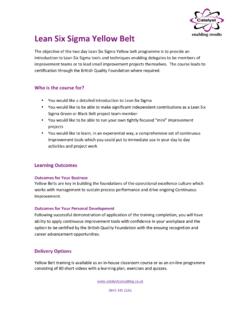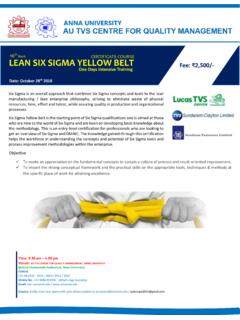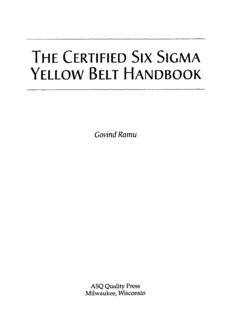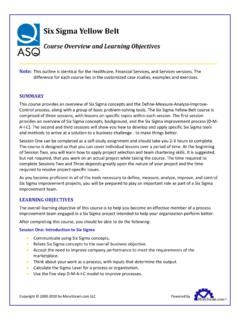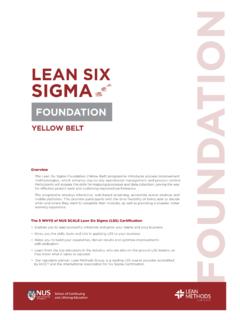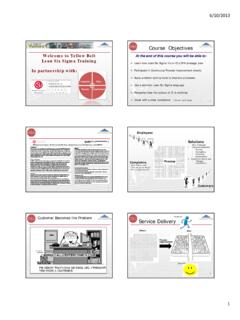Transcription of Table of Contents - Open Source Six Sigma
1 Copyright LSS yellow belt ManualTable of ContentsDefine PhaseUnderstanding Six Sigma 22 Selecting of Wrap Up and Action PhaseWelcome to Sigma System Capability ..200 Wrap Up and Action Items ..221 Control PhaseWelcome to Process Up and Action LSS yellow belt ManualLean Six Sigma yellow belt Training Now we will continue in the Define Phase with the Six Sigma Fundamentals .The output of the Define Phase is a well developed and articulated project. It has been correctly stated that 50% of the success of a project is dependent on how well the effort has been defined. There s that Y=f(X) thinking Phase Six Sigma Fundamentals Define Phase Six Sigma FundamentalsCopyright LSS yellow belt ManualSix Sigma FundamentalsOverviewWhat is a Process?What is a Process? Many people do or conduct a process everyday but do you really think of it as a process?
2 Our definition of a process is a repetitive and systematic series of steps or activities where inputs are modified to achieve a value-added a successful process needs to be well defined and developed. The core fundamentals of this phase are Process Maps, Voice of the Customer, Cost of Poor Quality and Process will examine the meaning of each of these and show you how to apply of the CustomerVoice of the CustomerCost of Poor QualityCost of Poor QualityProcess MapsProcess MapsProcess MetricsProcess MetricsSix Sigma FundamentalsSelecting ProjectsElements of WasteUnderstanding Six SigmaWrap Up & Action ItemsVoice of the CustomerVoice of the CustomerCost of Poor QualityCost of Poor QualityProcess MapsProcess MapsProcess MetricsProcess MetricsSix Sigma FundamentalsSelecting ProjectsSelecting ProjectsElements of WasteUnderstanding Six SigmaWrap Up & Action ItemsWrap Up & Action ItemsWhy have a process focus?
3 So we can understand how and why work gets done To characterize customer & supplier relationships To manage for maximum customer satisfaction while utilizing minimum resources To see the process from start to finish as it is currentlybeing performed Blame the process, notthe peopleproc ess (pros es) n. A repetitive and systematicseries of steps or activitieswhere inputsare modified to achieve a value-added outputproc ess (pros es) n. A repetitive and systematicseries of steps or activitieswhere inputsare modified to achieve a value-added outputWhy have a process focus? So we can understand how and why work gets done To characterize customer & supplier relationships To manage for maximum customer satisfaction while utilizing minimum resources To see the process from start to finish as it is currentlybeing performed Blame the process, notthe peopleproc ess (pros es) n.
4 A repetitive and systematicseries of steps or activitieswhere inputsare modified to achieve a value-added outputproc ess (pros es) n. A repetitive and systematicseries of steps or activitieswhere inputsare modified to achieve a value-added outputCopyright LSS yellow belt ManualExamples of ProcessesProcess Mapshave adequately mapped the are many reasons for creating a Process Map:- It helps all process members understand their part in the process and how their process fits into the bigger It describes how activities are performed and how the work effort flows, it is a visual way of standing above the process and watching how work is done. In fact, Process Maps can be easily uploaded into model and simulation software allowing you to simulate the process and visually see how it It can be used as an aid in training new It will show you where you can take measurements that will help you to run the process better.
5 - It will help you understand where problems occur and what some of the causes may It leverages other analytical tools by providing a Source of data and inputs into these It identifies many important characteristics you will need as you strive to make individual processes are linked together to see the total effort and flow for meeting business and customer needs. In order to improve or to correctly manage a process, you must be able to describe it in a way that can be easily understood. Process Mapping is the most important and powerful tool you will use to improve the effectiveness and efficiency of a Sigma FundamentalsWe go thru processes everyday. Below are some examples of processes. Can you think of other processes within your daily environment? Injection molding Decanting solutions Filling vial/bottles Crushing ore Refining oil Turning screws Building custom homes Paving roads Changing a tire Recruiting staff Processing invoices Conducting research Opening accounts Reconciling accounts Filling out a timesheet Distributing mail Backing up files Issuing purchase orders The purpose of Process Maps is to: Identify the complexity of the process Communicate the focus of problem solving Process Maps are livingdocuments and must be changed as the process is changed They represent what is currently happening, not what you think is happening.
6 They should be created by the people who are closest to the processStep AStartInspectFinishStep BStep CStep DProcess Map The purpose of Process Maps is to: Identify the complexity of the process Communicate the focus of problem solving Process Maps are livingdocuments and must be changed as the process is changed They represent what is currently happening, not what you think is happening. They should be created by the people who are closest to the processStep AStartInspectFinishStep BStep CStep DStep AStartInspectFinishStep BStep CStep DProcess MapProcess Mapping, also called flowcharting, is a technique to visualize the tasks, activities and steps necessary to produce a product or a service. The preferred method for describing a process is to identify it with a generic name, show the workflow with a Process Map and describe its purpose with an operational that a process is a blending of inputs to produce some desired output.
7 The intent of each task, activity and step is to add value, as perceived by the customer, to the product or service we are producing. You cannot discover if this is the case until you Copyright LSS yellow belt ManualProcess Map SymbolsAt a minimum a high level Process Map must include; start and stop points, all process steps, all decision points and directional flow. Also be sure to include Value Categories such as Value Added (Customer Focus) and Value Enabling (External Stakeholder focus).High Level Process MapThere may be several interpretations of some of the process mapping symbols; however, just about everyone uses these primary symbols to document processes. As you become more practiced you will find additional symbols useful, reports, data storage etc. For now we will start with just these Sigma FundamentalsStandard symbols for process mapping (available in Microsoft Office , Visio , iGrafx , SigmaFlow and other products):A RECTANGLE indicates an activity.
8 Statements within the rectangle should begin with a verbADIAMOND signifies a decision point. Only two paths emerge from a decision point: No and YesAn ELLIPSE shows the start and end of the processA PARALLELAGRAM shows that there are dataAn ARROW shows the connection and direction of flow1 ACIRCLE WITH A LETTER OR NUMBER INSIDE symbolizes the continuation of a flowchart to another pageStandard symbols for process mapping (available in Microsoft Office , Visio , iGrafx , SigmaFlow and other products):A RECTANGLE indicates an activity. Statements within the rectangle should begin with a verbADIAMOND signifies a decision point. Only two paths emerge from a decision point: No and YesAn ELLIPSE shows the start and end of the processA PARALLELAGRAM shows that there are dataAn ARROW shows the connection and direction of flow1 ACIRCLE WITH A LETTER OR NUMBER INSIDE symbolizes the continuation of a flowchart to another pageOne of the deliverables from the Define Phase is a high level process map, at a minimum it must include: Start and stop points All process steps All decision points Directional flow Value categories as defined below Value Added: Physically transforms the thing going through the process Must be done right the first time Meaningful from the customer s perspective (is the customer willing to pay for it?)
9 Value Enabling: Satisfies requirements of non-paying external stakeholders (government regulations) Non-Value Added Everything elseCopyright LSS yellow belt ManualProcess Map ExampleCall Center Process MapWhen multiple departments or functional groups are involved in a complex process it is often useful to use cross functional Process Functional Process MapSix Sigma FundamentalsSTARTLOGON TO PC &APPLICATIONSSCHEDULEDPHONE TIME?LOGONTO PHONECALL orWALK-IN?PHONE DATACAPTURE BEGINSDETERMINE WHOIS INQUIRINGACCESS CASE TOOLCASE TOOLRECORD?YNAZCALLWALK-INDETERMINE NATUREOF CALL & CONFIRMUNDERSTANDINGYNCBDPHONETIMEYNZBCR EVIEW CASETOOL HISTORY &TAKE NOTESPUT ON HOLD,REFER TOREFERENCESIMMEDIATERESPONSEAVAILABLE?Y NTRANSFERAPPROPRIATE?YNTRANSFERCALLANSWE R?YNQUERY INTERNALHRSC SME(S)ANSWER?YNOFF HOLD ANDARRANGE CALLBACK PHONE DATAENDSPROVIDERESPONSEPHONE&NOTEDATA ENDSDADD TORESEARCHLISTZLOGOFF PHONE, CHECKMAIL,E-MAIL,VOICE MAILSCHEDULEDPHONE TIME?
10 NYAEEXAMINE NEXT NOTEOR RESEARCH ITEMACCESS CASE TOOLENTER APPROPRIATESSAN (#,9s,0s)IF EMP DATA NOTPOPULATED, ENTEROLDCASEYNUPDATE ENTRIESINCL OPEN DATE/TIMECREATE A CASEINCL CASE TYPEDATE/TIME, &NEEDED BYAUTOROUTEYROUTECASECLOSEDNYNCLOSE CASEW/DATE/TIMEETAKE ACTIONorDO RESEARCHFGO TOF or EDEPENDING ONCASEFENEXTSTARTLOGON TO PC &APPLICATIONSSCHEDULEDPHONE TIME?LOGONTO PHONECALL orWALK-IN?PHONE DATACAPTURE BEGINSDETERMINE WHOIS INQUIRINGACCESS CASE TOOLCASE TOOLRECORD?YNAZCALLWALK-INDETERMINE NATUREOF CALL & CONFIRMUNDERSTANDINGYNCBDPHONETIMEYNZBCR EVIEW CASETOOL HISTORY &TAKE NOTESPUT ON HOLD,REFER TOREFERENCESIMMEDIATERESPONSEAVAILABLE?Y NTRANSFERAPPROPRIATE?YNTRANSFERCALLANSWE R?YNQUERY INTERNALHRSC SME(S)ANSWER?YNOFF HOLD ANDARRANGE CALLBACK PHONE DATAENDSPROVIDERESPONSEPHONE&NOTEDATA ENDSDADD TORESEARCHLISTZLOGOFF PHONE, CHECKMAIL,E-MAIL,VOICE MAILSCHEDULEDPHONE TIME?


